There are a lot of bandsaw blades available on the market for your taking as a metalworker.
Different types of bandsaw blades meet specific cutting needs, and you may be spoiled for a choice with no concrete idea how to select the best one for your needs.
Given the many brand options available, choosing the best bandsaw blades for metal also becomes confusing. This article explores some of the best bandsaw blades to help you in the selection and purchase process. Be sure to follow through to the end for greater insights.
At a Glance: Our Top Picks for Best Band Saw Blades For Metal
- OUR TOP PICK: Imachinist 72"
- BEST BUDGET OPTION: Hellbender Bimetal
- BEST 80 INCH BAND SAW BLADE METAL CUTTING: Imachinist S80121418
Comparison of the Best Band Saw Blades For Metal
| IMAGE | PRODUCT | |
|---|---|---|
Our Top Pick 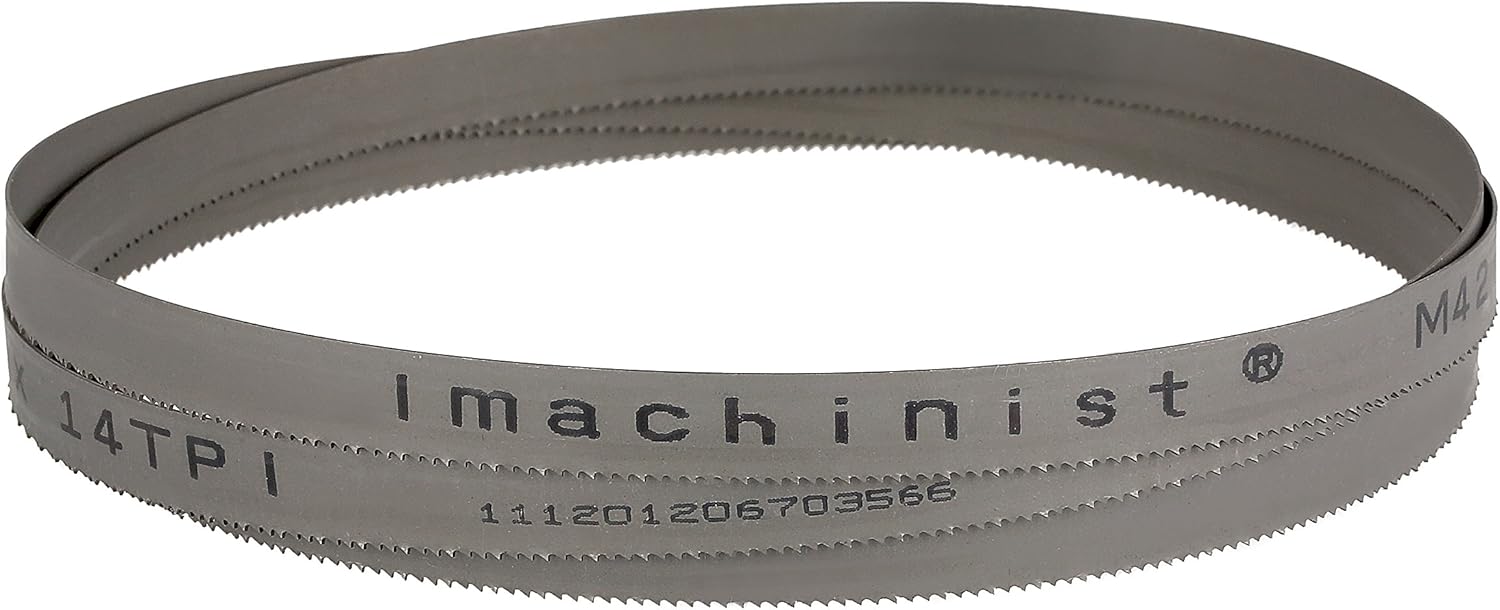 |
| View Latest Price → |
Best Budget Option 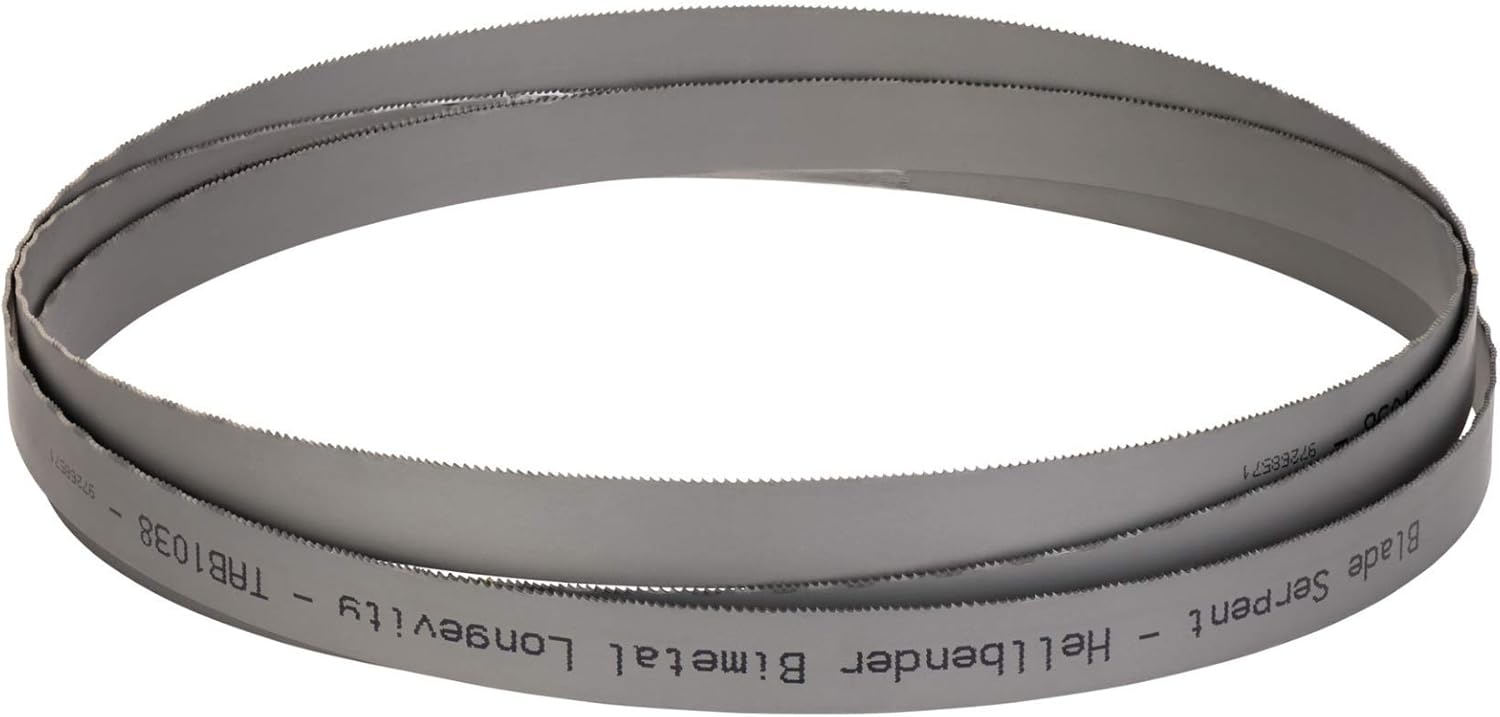 |
| View Latest Price → |
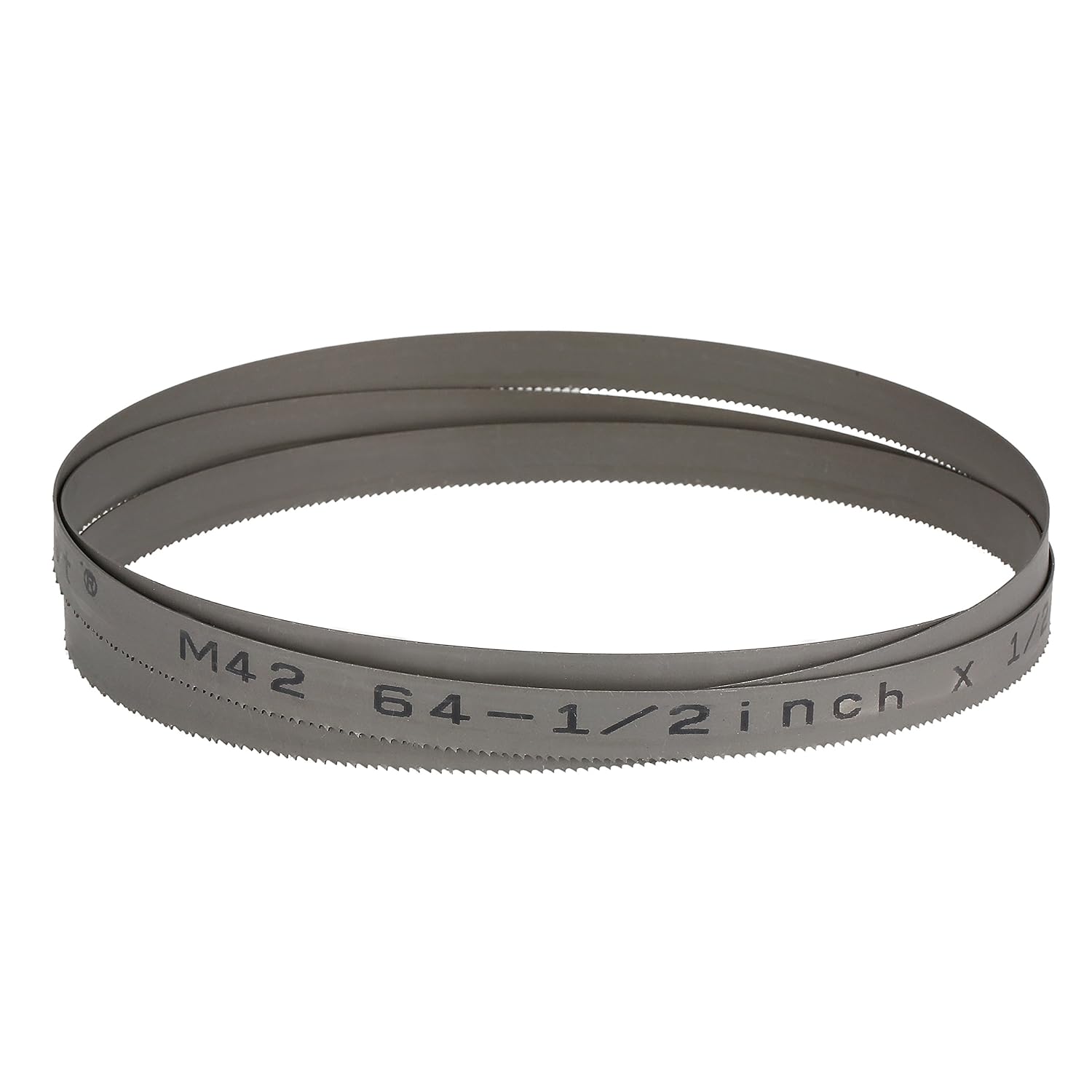 |
| View Latest Price → |
 |
| View Latest Price → |
What Makes a Great Band Saw Blade For Metal?
To maximize productivity in your workshop, consider a few factors to narrow down the wide array of choices. This way, you can be confident that you will find something close to the type you need keeping in mind there is no perfect blade for every application.
Tooth Pitch
The distance between two teeth tips on the blade.
Gullet
The curved region at the tooth base; gullet depth is thus the distance between the tooth tip to the gullet bottom.
Teeth Per Inch (TPI)
This is the teeth count per inch measured between gullets.
Tooth Rake Angle
Tooth face angle determined by an imaginary line perpendicular to the saw cutting direction.
Tooth Face
The tooth surface where the chip forms
Blade Length, Width, Thickness, and Material
Let’s see the significance of each of these parts in a band saw blade and how they impact the effectiveness during cutting.

Photo credit: trees2money.com
Tooth Geometry
Teeth are available in many shapes. The tooth shape will determine the number of things like cut quality, cutting efficiency, chip-carrying capacity, and overall blade life. The tooth set determines the overall cutting performance and is based on chip formation-particular in pinching applications.
- The five-tooth pattern (right, left, right, left, straight) on a blade raker is consistent to optimize surface finish and cutting efficiency.
- A raker blade sequence of odd numbers and uniform set angle makes the three-tooth sequence either left, right, straight (raker tooth), or unset.
Note: There is no raker tooth in an alternating set (teeth set left and right).
- The varying magnitudes and set angles are another option for a raker blade to support blade performance where work-hardening materials are inclined. It also helps reduce vibration and noise.
- A wavy blade has a consistent pitch of alternating set teeth (left and right).
Another aspect of the set is choosing between a dual-level set and a single-level set.
A dual-level set refers to the geometry of two tooth heights suitable for creating different cutting planes.
The single-level set, on the other hand, consists of one uniform tooth in the saw blade.
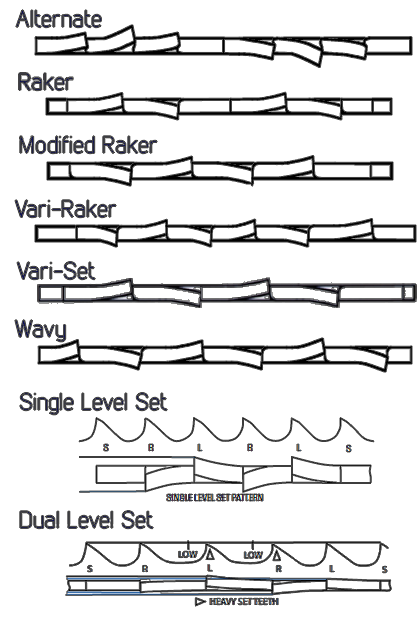
Photo credit: bandsawbladesking.com
Fine Teeth Setting
The pitch and TPI are other important factors to keep in mind. As a rule of thumb, a pitch of 0.5 inches equates to a TPI of 4. To achieve a more smother cut, decrease the pitch or increase the TPI, but note that a fine pitch is not the best for every cut.
Blade Length, Width, Thickness, and Material
The band saw has some non-negotiable specifications for the blade. These include thickness, length, and width that conform to the industry requirements.
The length of the blade determines band wheel spacing and size. The size between roller bearings and side guides determines the thickness.
Thicker blades are hard to pass through roller bearings or side guides. Thinner blades will also have a loose hold by roller guides which may cause a chattering noise, more vibration, and poor cut quality.
The widest blades promote the straightest cuts. The guideline here says that beam strength improves cut quality. The blade-build material will also affect its effectiveness.
Finally, here some common types of metal cutting blades you are likely to encounter in your search for a band saw blade:

Imachinist 72"
Bi-Metal Blades
These blades are made of two pieces and used across many applications, including metal fabrication. The high-speed steel edges can resist fatigue and have backers made of tempered alloy steel springs.
Carbide-Tipped Blades
Here, pocketed teeth are shaped in the backing material, and then carbide is ground and welded inside. This blade type is used more in cutting aerospace material such as titanium-based super alloys and nickel.
Recommended Blade Type and TPI Chart
Brand | Type | Tooth Size | Manufacturer |
|---|---|---|---|
Imachinist 72” | Bi-metal | 14/18 TPI | Imachinist |
PORTER-CABLE 45275-5 | Bi-metal | 14 TPI | PORTER-CABLE |
Hellbender Bimetal | Bi-metal | 4/6 TPI | Blade Serpent |
Imachinist S80121418 | Bi-metal | 14/18 TPI | Imachinist |
POWERTEC 13230 | Bi-metal | 14 TPI | POWERTEC |
Review of the Best Band Saw Blades for Metal
With an overview of how an ideal bandsaw blade for metal should look, let’s now review some of the best types available on the market today.
Best Overall:
Imachinist 72”

PROS
CONS
Specs
Weight: 6.4 ounces
Dimensions: 9.9 x 8.9 x 1 inches
Type: Bi-metal construction
Tooth Size: 14/18 TPI
Review
The Imachinist 72” is an ideal blade for cutting soft metals such as aluminum and copper. The varied teeth profile helps reduce vibration during cutting.
This bi-metal blade will work well in both woodworking and metalworking. The varied teeth profile of 14/18 TPI provides for smoother cutting but prone to dulling.
Bottom Line
The Imachinist 72” is a varied blade that will guarantee you fine cuts although done at a slower pace. The versatility makes it an ideal choice in cutting huge beams and also resawing. It may not be ideal, though, if you are looking for speed since most varied blades cut slow and dull very fast.
Best for the Money:
Hellbender Bimetal

PROS
CONS
Specs
Weight: 21.6 ounces
Dimensions: 12.2 x 11.8 x 1.8 inches
Type: Bimetal construction
Tooth Size: 4/6 TPI
Review
If you are looking for quality in terms of performance, durability, and versatility, then Hellbender bimetal blade wraps it all.
Assembled from across different continents, the M42 steel used is from Germany, world-class saw teeth fabrication is from China, and it’s twist-tested and laser welded in the USA.
The blade will fit horizontal band saws and is also ideal for medium and heavy productions. Shatter-resistant portable blades give bimetal M42 performance.
Although a little costly, Hellbender bimetal combines close to all features that will get the work done.
Bottom Line
The Hellbender bimetal is the ultimate band saw blade for cutting metals on this list.
This blade is made to last and also gives results. Its assembly across three continents is enough proof that, indeed, the blade optimizes your woodworking and metalworking craftsmanship.
The blade is heat resistant and has a multipurpose tooth design with a thick blade that will not flex easily during cutting.
Best 80 Inch Band Saw Blade Metal Cutting:
Imachinist S80121418

PROS
CONS
Specs
Weight: 5.93 Ounces
Dimensions: 9.49 x 8.43 x 1.14 inches
Type: Bi-metal
Tooth Size: 14/18 TPI
Review
This 14/18 TPI varied blade will suit both your woodworking and metalworking needs. The blade cuts slowly but produces fine cuts, making it suitable for resawing and production of veneers. Bimetal blade construction will last long but depending on how frequently and on what material you use the blade.
Keep in mind that a varied blade might need sharpening more often.
Bottom Line
If your workshop deals with metal and woodworks, then this two-in-one band saw blade is your go-to. Although the blade cuts slowly, it gives fine cuts, and you can use it when cutting both your beams and resawing them into thinner veneers.
Best 62 Inch Band Saw Blade Metal Cutting:
POWERTEC 13230
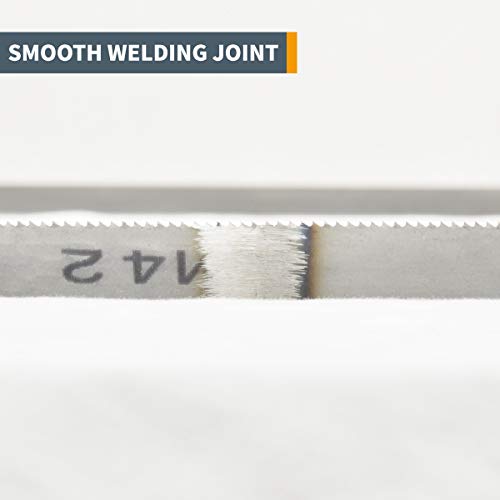
PROS
CONS
Specs
Weight: 6.4 ounces
Dimensions: 9.38 x 9.38 x 1.25 inches
Type: Bi-metal construction
Tooth Size: 14 TPI
Review
The Powertec 13230 uses high-speed M42 cobalt steel, which is highly heat resistant. The bimetal blade build has hard edges for faster cutting without flexing and will not break easily like carbon body blades.
Bimetal blades are very versatile as they will work in both woodworking and metalworking needs.
The 14 TPI produces rough cuts in comparison to varied teeth profiles. That, however, makes it faster and suitable where speed is a concern. Lower TPI also means the blade will not dull faster compared to a higher TPI count of over 32.
Bottom Line
Powertec 13230 is a bimetal blade that will guarantee durability, versatility, and low maintenance since it has a low TPI count and will not need frequent sharpening.
This saw blade might not be the appropriate choice if you want to cut smooth light materials, like veneers. Here, a varied blade will work better.
5. PORTER-CABLE 45275-5

PROS
CONS
Specs
Weight: 5 ounces
Dimensions: 20 x 7 x 1 inches
Type: Bimetal construction
Tooth Size: 14 TPI
Review
The bandsaw blade is very versatile and will cut through both non-ferrous metal and wood with ease. PORTER-CABLE 45275-5 bandsaw blade might not be the best when you need to cut hardened material like concrete.
Bottom Line
PORTER-CABLE 45275-5 is best for cutting softer materials like aluminum. The blade will last long enough due to its durable bi-metal construction. Additionally, this blade will give smooth cuts when used in cutting thinner material like slicing boards.
Price Points of Metal Cutting Band Saw Blades
The price factor is yet another key determinant of the type, quality, and brand of the band saw blade for metal you can acquire. Here are a few examples of some of the best blades categorized by their price.
$10-$20
Band saw blades in this price range are mostly used in light production. These blades for woodworking and metalworking are bimetal type, and most of them have varied blade profiles.
Although they combine most qualities like cobalt high-speed steel, these blades are a little thinner in width. Some of the best band saw blades found within this range include Powertec 13183X, Imachinist 72”,
Imachinist S80121418, and Powertec 13230.
$20 and Above
Band saw blades in this range are twist-tested, are made of durable steel mostly laser welded, are thicker, and ideal for large production.
These blades are best for commercial use and can be relied on to produce straight cuts as their blades will rarely flex during cutting.
The blades are multi-purpose and will work well on both wood and metal.
Some of the best blades here include Hellbender bi-metal, Timber Wolf Bandsaw Blade 1/2x80” 4TPI, Timber Wolf Bandsaw Blade 1/2x80” 3TPI.
Note: Woodworking is less demanding and you’ll find heavy-duty bandsaw blades at a price of below $20.
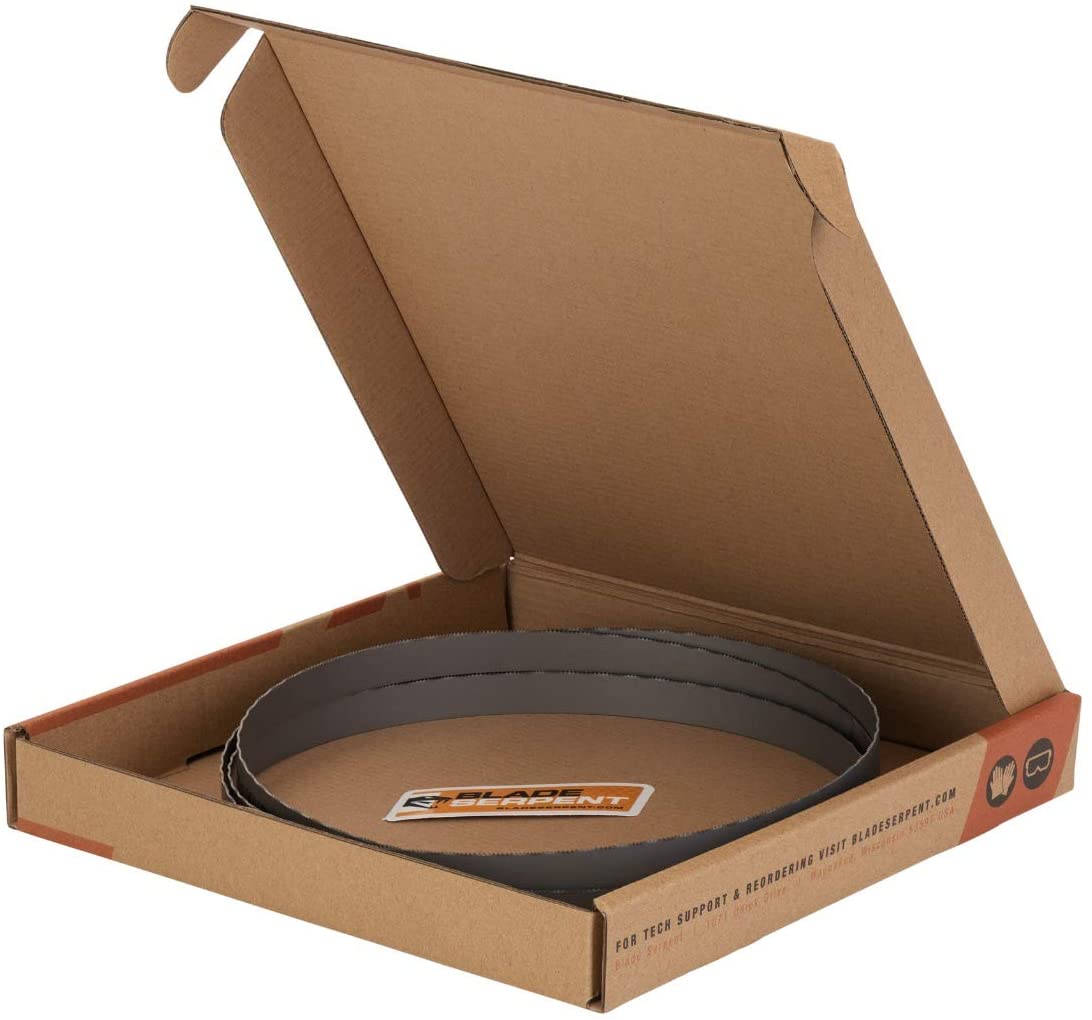
Hellbender Bimetal
Conclusion
Increased productivity and efficiency to a wider degree depends on the type of band saw blade you choose to purchase, and of course, your craftsmanship.
Next time you set out to buy a band saw blade for metals, you may need to pay close attention to the blade features as expounded in the article, the cost, and what you intend to use it on. Pay close attention to the TPI structure as among the key determinants of your cutting output.
Recap - Best Band Saw Blades For Metal
Heading out? Here's a refresher on our best band saw blades for metal:
People Also Ask
A band saw blade requires some knowledge on maintenance, proper use, safety measures, and tips on actions to take in case of breakdowns.
Next, we answer some of the common questions asked by both new users and those intending to acquire band saw blades.
How Do You Break in a Metal Bandsaw Blade?
To break-in a metal band saw blade, let the machine run at the usual surface feet per minute. For softer materials that include aluminum and carbon steel, adjust feed pressure to 50 of the normal cutting rate.
You can gradually increase the pressure to 100 for the first 50-100 square inches. Adjust to 75 and increase gradually to 100 for harder materials to avoid causing vibrations.
What Happens When a Bandsaw Blade Breaks?
When a bandsaw blade breaks, you should not panic about it shooting off to cause danger.
Although it can get badly tangled in the motor, which may keep running after the band saw breaks, in most cases, the tension released causes the blade to stop. You can then remove it safely after pressing the stop button on the bandsaw.
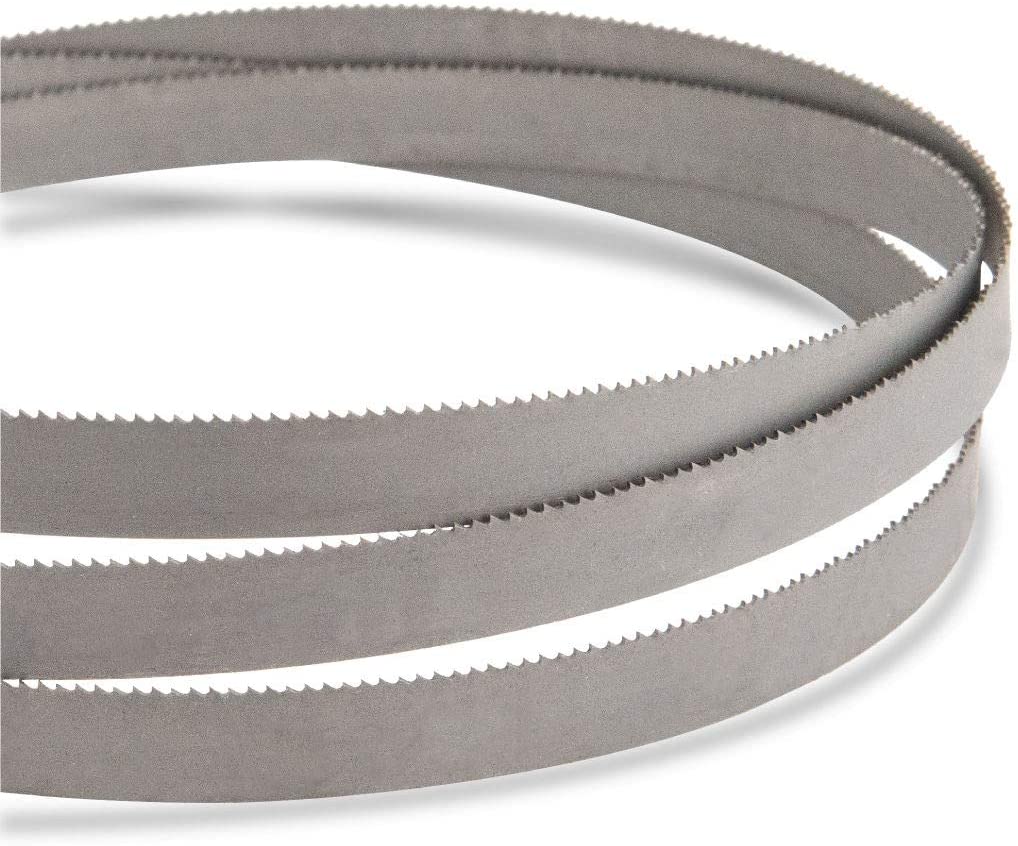
POWERTEC 13230
How Long Should a Bandsaw Blade Last?
The lifespan of your bandsaw blade depends entirely on factors that include how often you’ll be using the blade, the material you’ll be cutting, the material used in building, the blade, and, of course, the general maintenance of the machine.
For the average user, the blade can last somewhere between six months to a year or more.
When is it Time to Replace My Band Saw Blade?
A few signs to watch out for when a bandsaw blade replacement is due, include stripping teeth after prolonged use, the blade becoming squeaky and noisy, and inconsistent movement when the blade is cutting.
The hairline might also start cracking as a sign of stress and overuse.
Are All Band Saw Blades Universal?
Many varieties of bandsaw blades made with varying features to address different applications are a pointer that not all bandsaw blades are universal.
While you’ll be able to adjust your band saw settings to suit a particular application, it may work but not with the level of intended effectiveness. Various blades may serve in both wood and metal cutting works.
